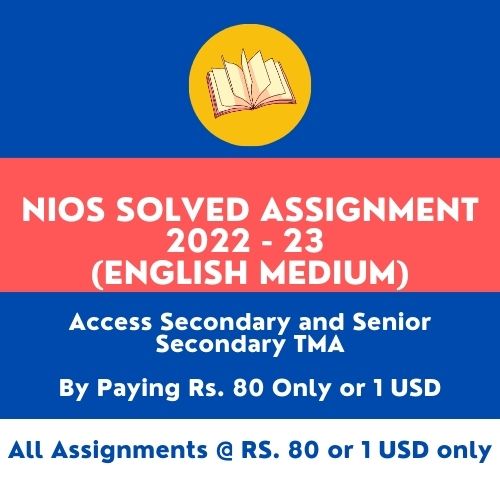NIOS Free Solved Assignment [TMA] 2022 – 2023
Tourism 337 Free Solved Assignment [TMA] 2022 – 23
Tutor Marked Assignment
Max. Marks: 20
In this article, you will get Tourism 337 Free Solved Assignment [TMA] 2022-23. You will solved assignment of other subjects in our page nios solved assignment 202-23.

Note:
(i) All questions are compulsory. The marks allotted for each question are given beside the questions.
(ii) Write your name, enrollment numbers. AI name, and subject on the first page of the answer sheet.
1. Answer any one of the following questions in about 40-60 words. 2
(a) Differentiate between Culture and Heritage. (See Lesson-6)
Ans: Culture is the aggregation of a community’s beliefs, attitudes, approaches, behaviors and the social artifacts that communicate them.
Heritage relates to inheritance, meaning passing of the beliefs, objects and culture from one generation to the next, like a tradition.
Heritage is what we inherit from our ancestors, like oral traditions and values, while culture is the set of beliefs and behaviors of a particular group.
(b) Find out various components of tourism industry, and explain them in brief. (See Lesson-2)
Ans: Answer any one question
2. Answer any one of the following questions in about 40-60 words. 2
(a) Differentiate between Hindustani and Carnatic music. (See Lesson-11)
Ans: Hindustani classical music has primarily been vocal centric. This is implied by the term ‘Sangeet’ itself that is used for music, which literally means ‘singing in a correct way’. Most of the forms were originally suited for vocal performance and instruments were designed to emulate the human voice. Singing, instrumental music and dance together constituted music or ‘Sangeet’.
Carnatic Music is very distinct in several aspects such as its melodic nature, the sruti concept, importance of gamaka and its improvisational capacity etc. and above all, its serene nature. The ragas of Indian Music have been always a fascination to the west; with its infinitive creativity, just like the intricate and mind blowing tala system.
(b) Examine how Physiography of India promotes tourism activities? (See Lesson-12)
Ans: Answer any one question
3. Answer any one of the following questions in about 40-60 words. 2
(a) Identify any two antecedents of modern Tourism, and explain them in brief. (See Lesson-1)
Ans: Nomadism: Nomads were people who travelled from place to place in search of food. Even today, you will find many people moving on caravans with their children and their entire belongings. We have read that this movement of people was concerned with survival. Now a-days, it is confined to places like deserts or mountains where food is not available.
Pilgrimage: Pilgrimage is a journey to holy places as per the beliefs and faith. Many religions attach importance to certain places like the birth or death of the founders of the spiritual awakening. These places have great significance for the believers. In modern times, pilgrimage has become a source of mass tourism, because as development of transport and other facilities increased the number of people visiting such places increased too.
(b) The National fairs of India also attract the tourists. Elaborate with examples. (See Lesson-11)
Ans: Answer any one question
4. Answer any one of the following questions in about 100-150 words. 4
(a) List out the various functions of Management. (See Lesson-15)
Ans: According to Henry Fayol, in every organisation manager perform certain functions to achieve results. These functions are broadly classified under five categories:
a) Planning: Planning is a process of making decision about future. It provides direction to enterprise activities. Its work is to decide in advance what is to be done, when and where it is to be done, how it is to be done and by whom. The main functions of planning are Set up goals, Forecasting, Search for alternatives source of action and Budgeting.
b) Organising: It is concerned with the arrangement of an organisation’s resources – people, material, technology and finances in order to achieve enterprise objective. The main functions of organising are Job design, Job specification and Authority and responsibility.
c) Staffing: Staffing is the function of employing suitable personas for the enterprise. It may be defined as an activity where people are recruited, selected, trained, developed, motivated and compensated for manning various positions.
d) Directing: According to Dale, direction is telling people what to do and seeing that they do it to the best of their ability. Directing is a function of guiding and supervising the activities of sub ordinates. Its main elements are leadership, motivation and communication.
e) Controlling: It is the management function concerned with monitoring employee’s activities, keeping the organisation on track towards its goals, and making corrections as required.
(b) The growth of educational institutions in the past led to growth in tourist activities. Illustrate with examples. (See Lesson-1)
Ans: Answer any one question
5. Answer any one of the following questions in about 100-150 words. 4
(a) Examine the role, and importance of HRM in Tourism Industry. (See Lesson-16)
Ans: Answer any one question
(b) Distinguish between On-the-Job training methods, and Off- the-Job training methods. (See Lesson-17)
Ans: On-the-job training: When the employees are trained while they are performing the job then it is known as On-the-job training. Under this method the employees learn by doing. This method is suitable only for technical jobs and the advantage of this method is employees can learn the practical problems while working on the job. The biggest disadvantage of on-the-job training is that it results in wastage of resources.
Off-the-job training: Off-the-job training means training the employees by taking them away from their work position which means employees are given a break from the job and sent for training. This method of training is more suitable for managerial job positions as conferences, seminars are held to train the managers.
6. Prepare any one project out of the given below: 6
(a) Make a list of tourist destinations in your area. Also find out how corona pandemic affected them? (See Lesson-16)
Ans: Answer any one question
(b) Make a list of festivals in India, and describe in detail how you celebrate your favourite festival?(See Lesson-11)
Ans: Simple Steps To Get All the Assignments
1. Simply Pay Rs. 80 Inclusive of taxes through the following Link
2. Download DTS Mobile Application
3. Go to NIOS Solved Assignment (TMA) to Access all the assignments
4. Amazing All the TMA of Secondary and Senior Secondary for Just Rs. 80 Only
Or
So, Finally you reached the end of the post. Hope you like Tourism 337 Free Solved Assignment [TMA] 2022-23. You will solved assignment of other subjects in our page nios solved assignment 202-23. Visit Official website of NIOS for details about assignment.
***
